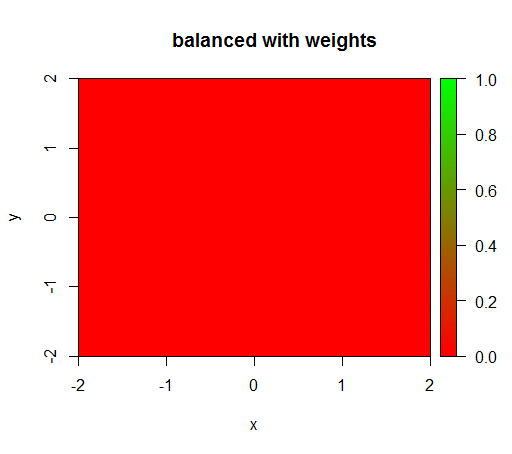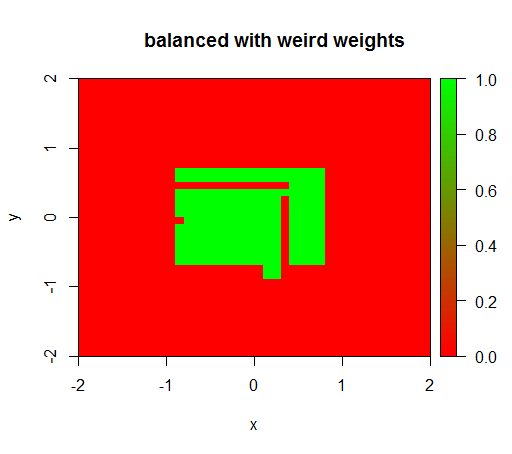Question in one sentence: Does somebody know how to determine good class weights for a random forest?
Explanation:
I am playing around with imbalanced datasets. I want to use the R package randomForest in order to train a model on a very skewed dataset with only little positive examples and many negative examples. I know, there are other methods and in the end I will make use of them but for technical reasons, building a random forest is an intermediate step. So I played around with the parameter classwt. I am setting up a very artificial dataset of 5000 negative examples in the disc with radius 2 and then I sample 100 positives examples in the disc with radius 1. What I suspect is that
1) without class weighting the model becomes 'degenerate', i.e. predicts FALSE everywhere.
2) with a fair class weighting I will see a 'green dot' in the middle, i.e. it will predict the disc with radius 1 as TRUE although there are negative examples.
This is how the data looks like:
This is what happens without weighting: (call is: randomForest(x = train[, .(x,y)],y = as.factor(train$z),ntree = 50))
For checking I have also tried what happens when I violently balance the dataset by downsampling the negative class so that the relationship is 1:1 again. This gives me the expected result:
However, when I compute a model with a class weighting of 'FALSE' = 1, 'TRUE' = 50 (this is a fair weighting as there are 50 times more negatives than positives) then I get this:
Only when I set the weights to some weird value like 'FALSE' = 0.05 and 'TRUE' = 500000 then I get senseful results:
And this is quite unstable, i.e. changing the 'FALSE' weight to 0.01 makes the model degenerate again (i.e. it predicts TRUE everywhere).
Question: Does somebody know how to determine good class weights for a random forest?
R code:
library(plot3D)
library(data.table)
library(randomForest)
set.seed(1234)
amountPos = 100
amountNeg = 5000
# positives
r = runif(amountPos, 0, 1)
phi = runif(amountPos, 0, 2*pi)
x = r*cos(phi)
y = r*sin(phi)
z = rep(T, length(x))
pos = data.table(x = x, y = y, z = z)
# negatives
r = runif(amountNeg, 0, 2)
phi = runif(amountNeg, 0, 2*pi)
x = r*cos(phi)
y = r*sin(phi)
z = rep(F, length(x))
neg = data.table(x = x, y = y, z = z)
train = rbind(pos, neg)
# draw train set, verify that everything looks ok
plot(train[z == F]$x, train[z == F]$y, col="red")
points(train[z == T]$x, train[z == T]$y, col="green")
# looks ok to me :-)
Color.interpolateColor = function(fromColor, toColor, amountColors = 50) {
from_rgb = col2rgb(fromColor)
to_rgb = col2rgb(toColor)
from_r = from_rgb[1,1]
from_g = from_rgb[2,1]
from_b = from_rgb[3,1]
to_r = to_rgb[1,1]
to_g = to_rgb[2,1]
to_b = to_rgb[3,1]
r = seq(from_r, to_r, length.out = amountColors)
g = seq(from_g, to_g, length.out = amountColors)
b = seq(from_b, to_b, length.out = amountColors)
return(rgb(r, g, b, maxColorValue = 255))
}
DataTable.crossJoin = function(X,Y) {
stopifnot(is.data.table(X),is.data.table(Y))
k = NULL
X = X[, c(k=1, .SD)]
setkey(X, k)
Y = Y[, c(k=1, .SD)]
setkey(Y, k)
res = Y[X, allow.cartesian=TRUE][, k := NULL]
X = X[, k := NULL]
Y = Y[, k := NULL]
return(res)
}
drawPredictionAreaSimple = function(model) {
widthOfSquares = 0.1
from = -2
to = 2
xTable = data.table(x = seq(from=from+widthOfSquares/2,to=to-widthOfSquares/2,by = widthOfSquares))
yTable = data.table(y = seq(from=from+widthOfSquares/2,to=to-widthOfSquares/2,by = widthOfSquares))
predictionTable = DataTable.crossJoin(xTable, yTable)
pred = predict(model, predictionTable)
res = rep(NA, length(pred))
res[pred == "FALSE"] = 0
res[pred == "TRUE"] = 1
pred = res
predictionTable = predictionTable[, PREDICTION := pred]
#predictionTable = predictionTable[y == -1 & x == -1, PREDICTION := 0.99]
col = Color.interpolateColor("red", "green")
input = matrix(c(predictionTable$x, predictionTable$y), nrow = 2, byrow = T)
m = daply(predictionTable, .(x, y), function(x) x$PREDICTION)
image2D(z = m, x = sort(unique(predictionTable$x)), y = sort(unique(predictionTable$y)), col = col, zlim = c(0,1))
}
rfModel = randomForest(x = train[, .(x,y)],y = as.factor(train$z),ntree = 50)
rfModelBalanced = randomForest(x = train[, .(x,y)],y = as.factor(train$z),ntree = 50, classwt = c("FALSE" = 1, "TRUE" = 50))
rfModelBalancedWeird = randomForest(x = train[, .(x,y)],y = as.factor(train$z),ntree = 50, classwt = c("FALSE" = 0.05, "TRUE" = 500000))
drawPredictionAreaSimple(rfModel)
title("unbalanced")
drawPredictionAreaSimple(rfModelBalanced)
title("balanced with weights")
pos = train[z == T]
neg = train[z == F]
neg = neg[sample.int(neg[, .N], size = 100, replace = FALSE)]
trainSampled = rbind(pos, neg)
rfModelBalancedSampling = randomForest(x = trainSampled[, .(x,y)],y = as.factor(trainSampled$z),ntree = 50)
drawPredictionAreaSimple(rfModelBalancedSampling)
title("balanced with sampling")
drawPredictionAreaSimple(rfModelBalancedWeird)
title("balanced with weird weights")





